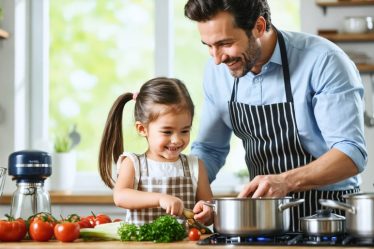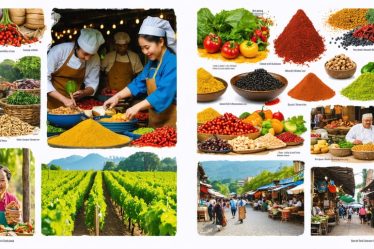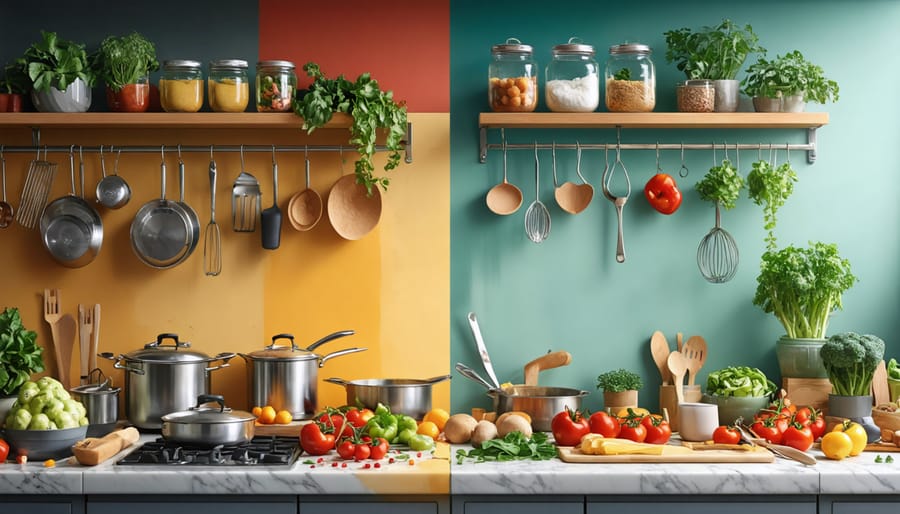
The aroma of fresh-baked bread wafting through your kitchen isn’t just a sensory experience – it’s a powerful psychological catalyst that can transform your mental state and emotional well-being. Every time we step into our kitchens, we’re not just preparing meals; we’re engaging in an intricate dance between mind and matter that shapes our relationship with food, creativity, and self-care.
Culinary psychology, the fascinating intersection of food science and behavioral studies, reveals how our cooking habits both reflect and influence our mental health. Research shows that mindful cooking practices can reduce stress levels by up to 75% and boost feelings of accomplishment and self-worth. When we understand the psychological principles behind our cooking behaviors, we can harness them to create not just better meals, but better mental states.
Think about the last time you lovingly prepared a family recipe – the memories it stirred, the emotions it evoked, and the sense of connection it created. This isn’t just nostalgia; it’s your brain processing complex psychological cues that influence everything from taste perception to emotional satisfaction. By understanding these connections, we can transform our daily cooking routines into powerful tools for emotional regulation and personal growth.
Whether you’re a seasoned chef or a kitchen novice, the principles of culinary psychology offer a fresh perspective on how food preparation can become a form of self-care, creative expression, and emotional healing. Let’s explore how understanding the psychology behind our cooking habits can lead to more mindful, joyful, and therapeutic culinary experiences.
The Mind-Kitchen Connection
Your Kitchen’s Hidden Language
Have you ever noticed how your kitchen tells a story about your state of mind? As a home cook who’s experienced both chaotic and zen-like kitchen moments, I’ve discovered that our cooking spaces often mirror our inner world.
Think about those days when stress feels overwhelming – your counter might be cluttered with half-opened ingredients, utensils scattered everywhere, and yesterday’s dishes still lingering in the sink. Contrast that with moments of clarity, when everything has its place, ingredients are thoughtfully arranged, and cooking flows effortlessly.
Your cooking habits speak volumes too. Quick, aggressive chopping might signal anxiety or time pressure, while methodical meal prep often reflects a centered, present mindset. I’ve found that simply reorganizing my spice rack or tidying my pantry can shift my mood from frazzled to focused.
Here’s what your kitchen might be telling you:
– Cluttered counters often signal a scattered mind
– Clean, organized spaces typically reflect inner calm
– Rushed cooking habits may indicate stress
– Mindful food preparation suggests emotional balance
The good news? This relationship works both ways. By consciously creating order in your kitchen, you can actually help restore mental clarity. Start small – maybe with one drawer or shelf. As you bring intention to your cooking space, you might be surprised how your mindset shifts too.
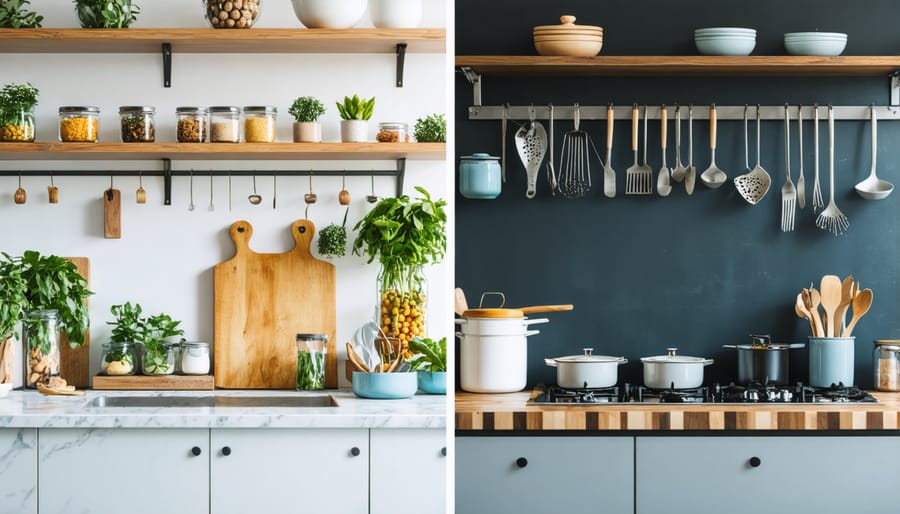
The Emotional Flavor Profile
Have you ever noticed how your mood affects what you crave or cook? Just as we’re drawn to comfort food when feeling down, our emotional state plays a fascinating role in our culinary choices and taste perceptions. As someone who’s experienced the deep connection between feelings and flavors, I’ve learned that understanding this relationship can transform our cooking journey.
Research shows that emotions can literally change how food tastes to us. When we’re happy, our sensitivity to sweetness increases, while stress can make us more receptive to salty and fatty foods. This explains why that chocolate cake tastes especially divine during celebrations or why we reach for chips during tense moments.
What’s remarkable is how this knowledge can help us make better cooking decisions. By incorporating mindful eating practices into our routine, we can become more aware of how our emotions influence our food choices. For instance, before cooking, take a moment to check in with your emotional state. Are you cooking from a place of joy, stress, or perhaps nostalgia?
Understanding your emotional flavor profile isn’t about judgment – it’s about awareness and connection. Maybe you’ve noticed that when you’re feeling creative, you’re more likely to experiment with spices, or when you’re seeking comfort, you gravitate toward family recipes. These patterns are personal and valid, offering insights into how we can use cooking not just for nourishment, but as a tool for emotional well-being.
Mindful Cooking Practices
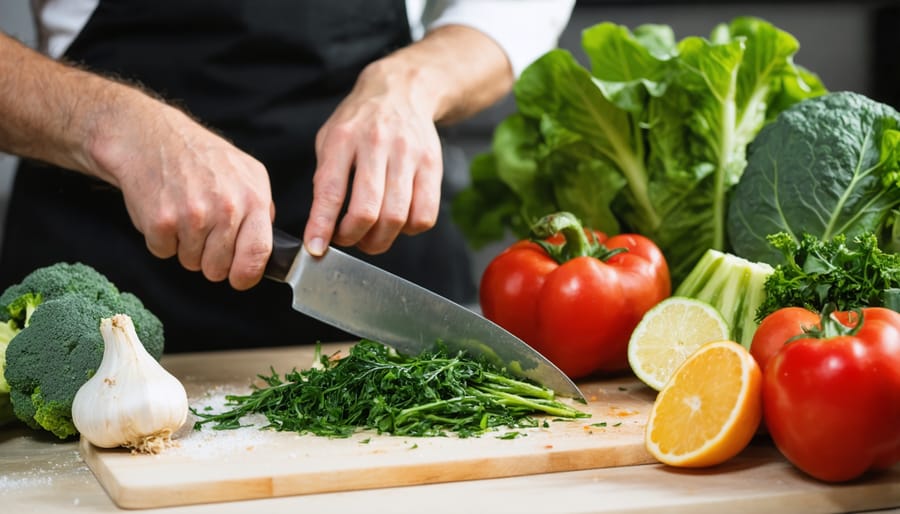
Present Moment Preparation
Have you ever noticed how different cooking feels when you’re rushing versus when you’re truly present in the moment? As someone who used to dash through meal prep like it was a race, I’ve discovered that developing mindful cooking habits has completely transformed my relationship with food preparation.
Being present while cooking isn’t just about moving slower – it’s about engaging all your senses and finding joy in each step of the process. Start by taking three deep breaths before you begin cooking. Feel the weight of the knife in your hand, notice the vibrant colors of fresh produce, and appreciate the aromatic symphony as ingredients come together.
Try this simple technique: when chopping vegetables, focus solely on the rhythmic motion of the knife and the clean sound it makes as it meets the cutting board. You’ll find that this mindful approach not only makes the process more enjoyable but also leads to more consistent, precise cuts.
Another powerful practice is to engage with your ingredients mindfully. Before you start cooking, take a moment to appreciate where your food came from – the farmers who grew it, the journey it took to reach your kitchen. This connection adds a layer of gratitude to your cooking experience and often results in more thoughtful, careful preparation.
The benefits of present moment cooking extend beyond the kitchen. Many home cooks report feeling less stressed, more creative, and more satisfied with their finished dishes when they practice mindful preparation. It’s like meditation in motion – each stir, chop, and seasoning becomes an opportunity to ground yourself in the present moment.
Remember, this isn’t about perfection. Some days, you might feel more present than others, and that’s perfectly okay. The key is to approach cooking with intention and awareness, allowing the process to become a form of self-care rather than just another task to complete.
The Conscious Kitchen Ritual
Transforming your kitchen into a sanctuary of mindful cooking begins with establishing intentional routines that nourish both body and soul. As someone who once viewed cooking as just another task to check off my daily list, I’ve discovered how conscious kitchen rituals can create joyful cooking experiences that ground us in the present moment.
Start by setting the stage for your culinary practice. Clear your countertops of unnecessary items, creating a clean canvas for creativity. Light a favorite candle, play soft background music, or open a window to let in fresh air. These simple acts signal to your brain that you’re entering a special time dedicated to nourishing yourself and others.
Before diving into meal preparation, take three deep breaths while setting an intention for your cooking session. Whether it’s channeling love into a family meal or practicing self-care through solo cooking, this moment of reflection adds deeper meaning to your kitchen time.
Embrace the sensory experience of cooking: feel the weight of fresh vegetables in your hands, inhale the aroma of herbs, listen to the sizzle of ingredients hitting a hot pan. These mindful observations help anchor you in the present moment and enhance your connection to the food you’re preparing.
Consider establishing specific rituals that mark the beginning and end of your cooking sessions. Maybe it’s donning a favorite apron, arranging ingredients in order of use, or saying a small gratitude prayer before starting. These ceremonies, however simple, can transform ordinary cooking into a meditative practice.
Remember that conscious cooking isn’t about perfection – it’s about presence. Some days, you might only have time for a quick five-minute mindful moment while preparing breakfast. Other days might allow for longer, more elaborate kitchen ceremonies. What matters is the intention you bring to the experience and the joy you find in the process.
From Stress to Success in the Kitchen
Turning Kitchen Anxiety into Confidence
Every home chef has experienced that moment of panic when facing a new recipe or cooking for guests. But here’s the good news: kitchen anxiety is both normal and conquerable. The key is to transform your relationship with cooking from one of stress to one of creative expression and joy.
Start by breaking down complex tasks into manageable steps. Rather than viewing a recipe as one overwhelming challenge, see it as a series of small, achievable actions. For instance, before starting, simply organize your ingredients and tools – this alone can reduce anxiety significantly.
Remember that perfection isn’t the goal; learning is. I once burned a batch of cookies so badly they set off the smoke alarm, but that experience taught me more about oven temperature management than any successful bake ever did. These “kitchen fails” are stepping stones to expertise.
Build confidence through repetition. Choose three to four simple recipes and master them completely. As you become comfortable with these dishes, you’ll naturally develop intuition about cooking times, temperatures, and seasoning levels. This foundation makes trying new recipes less daunting.
Create a positive kitchen environment that works for you. Put on your favorite music, ensure good lighting, and keep your most-used tools within easy reach. Some of my most relaxed cooking sessions happen when I’m dancing between the stove and prep area!
Finally, celebrate small victories. Successfully minced garlic? That’s worth noting. Made a sauce from scratch? Take a moment to appreciate your progress. Each small success builds the confidence needed for bigger culinary adventures.
Creating Your Culinary Safe Space
Creating a positive kitchen environment is like building a sanctuary where culinary creativity can flourish. I remember when I first realized how much my cluttered countertops were affecting my cooking motivation – a simple reorganization transformed my entire approach to meal preparation.
Start by decluttering your workspace. A tidy kitchen isn’t just about aesthetics; it creates mental clarity that allows you to focus on the joy of cooking rather than feeling overwhelmed. Arrange your most-used items within easy reach, and consider creating dedicated zones for different activities – prep space, cooking area, and cleanup station.
Lighting plays a crucial role in setting the mood. Natural light is ideal, but if that’s limited, invest in warm, welcoming lighting that makes your kitchen feel inviting. Many of my readers have shared how adding a small lamp or under-cabinet lighting transformed their evening cooking experience from a chore to a pleasure.
Personalize your space with elements that bring you joy. Perhaps it’s a cherished family recipe framed on the wall, a collection of beautiful cooking vessels, or even a small herb garden on the windowsill. These personal touches create an emotional connection to your cooking space.
Consider the sensory experience – pleasant scents from essential oils or fresh herbs, comfortable flooring that supports long cooking sessions, and maybe even a dedicated speaker for your favorite cooking playlist. Remember, your kitchen should reflect your personality and cooking style while supporting your culinary journey.
Most importantly, establish boundaries that protect your kitchen as your safe space. This might mean setting specific times for uninterrupted cooking or creating kitchen rules that help maintain the positive environment you’ve created.
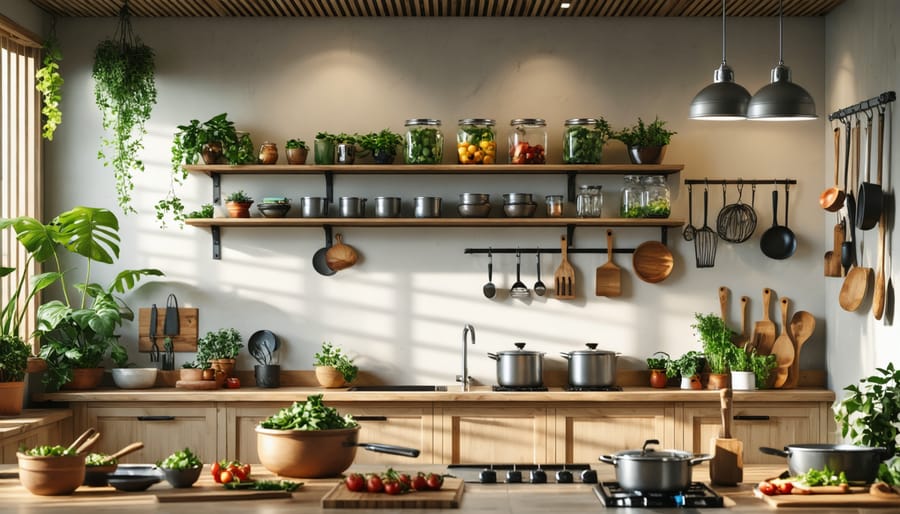
As we wrap up our journey through the fascinating world of culinary psychology, remember that your kitchen is more than just a place to prepare meals – it’s a sanctuary for emotional expression, mindful practice, and personal growth. By understanding how our thoughts and feelings influence our cooking experiences, we can transform everyday meal preparation into an enriching ritual that nourishes both body and soul.
Whether you’re experimenting with color psychology in your plating, practicing mindful cooking to reduce stress, or using baking as a form of emotional expression, the principles we’ve explored can help create more meaningful connections with food and the cooking process. Start small – perhaps by setting an intention before cooking your next meal or paying closer attention to how different cooking activities affect your mood.
Remember, there’s no one-size-fits-all approach to culinary psychology. What brings one person joy in the kitchen might feel overwhelming to another, and that’s perfectly okay. The key is to discover your own unique relationship with cooking and nurturing it in a way that serves your well-being.
I encourage you to share these insights with friends and family, creating a community of conscious cooks who understand the powerful connection between food and psychology. Try incorporating one new technique from this article each week, and notice how it impacts your cooking experience and overall mood.
Let’s embrace cooking not just as a daily task, but as an opportunity for self-discovery, emotional regulation, and joy. Your kitchen awaits as a laboratory for personal growth – what will you create today?

